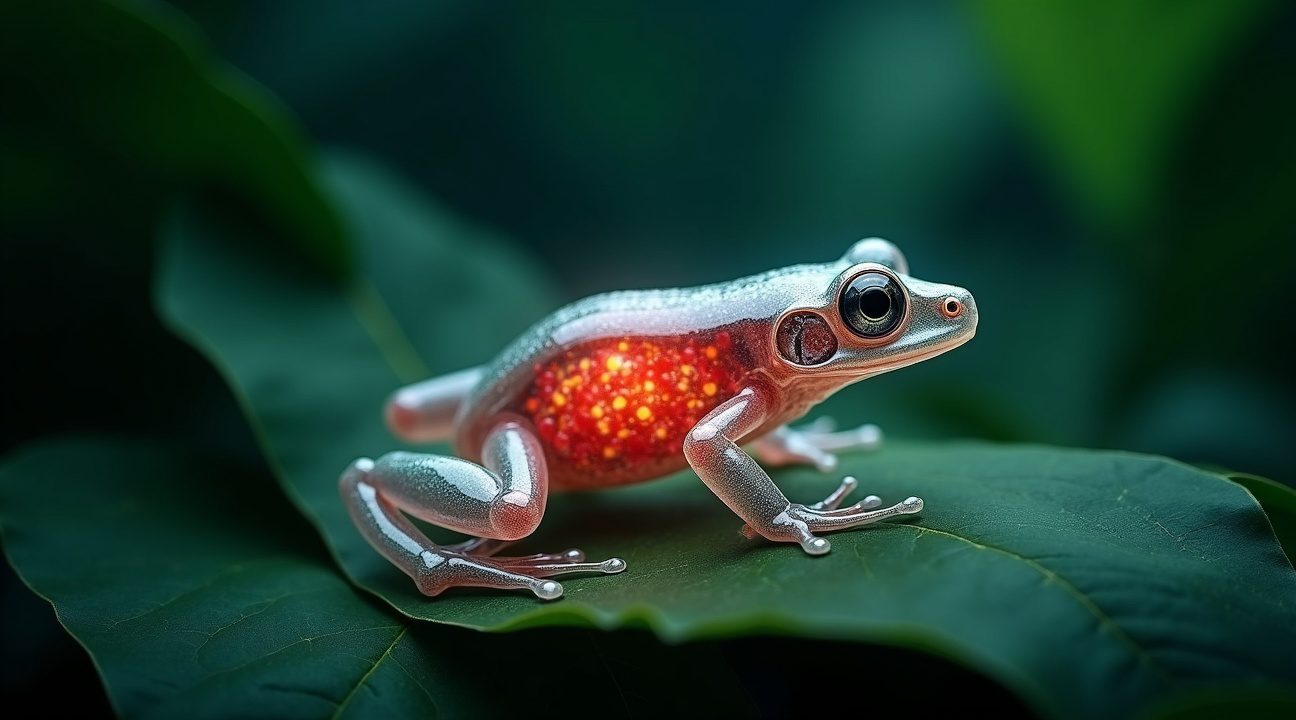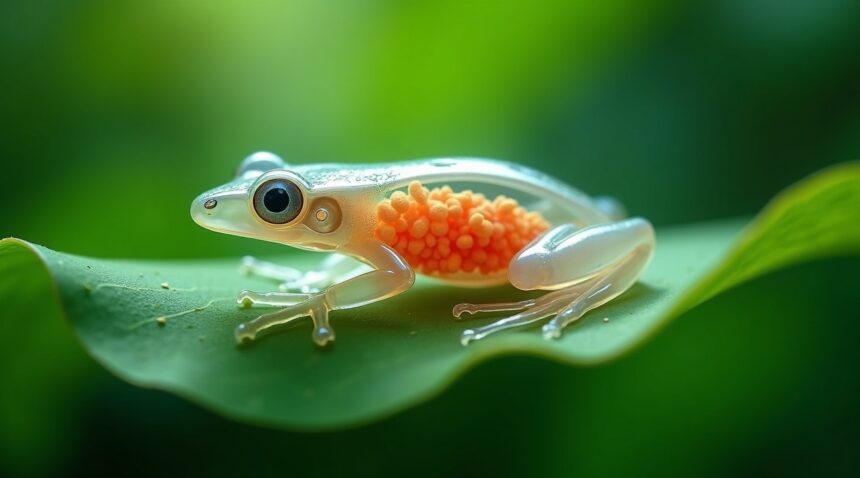Glass frogs achieve near-perfect transparency through a remarkable biological mechanism where they store approximately 90% of their red blood cells in their liver during rest periods.
This extraordinary adaptation allows these tiny amphibians to become virtually invisible to predators while they sleep. Remarkably, glass frogs are the only land vertebrates known to achieve true transparency, a trait typically limited to aquatic animals.
Key Takeaways
- Glass frogs concentrate up to 90% of their red blood cells in their liver while sleeping, increasing their transparency by two to three times compared to their active state.
- Photoacoustic imaging was used by scientists to uncover this impressive blood storage mechanism, which revealed an 80-90% decrease in circulating red blood cells during the frogs’ transparent state.
- These amphibians are unique among land vertebrates in attaining actual transparency, overcoming biological challenges not faced by their aquatic counterparts.
- They avoid fatal blood clots despite extreme concentration of red blood cells in their liver—something that would typically be deadly for vertebrates, including humans.
- This discovery may have profound medical implications: the clot-prevention mechanisms in glass frogs could inspire breakthroughs in treating cardiovascular disease and developing improved blood storage technologies.
You can learn more about how scientists used photoacoustic imaging to study glass frogs and their fascinating biology in greater detail.
How Glass Frogs Store 90% of Their Blood to Vanish at Night
Glass frogs perform one of nature’s most remarkable vanishing acts by strategically relocating their red blood cells during periods of rest. These tiny amphibians, particularly the species Hyalinobatrachium fleischmanni, concentrate up to 90% of their red blood cells in their liver while sleeping or remaining motionless. This extraordinary biological process dramatically reduces light absorption throughout their circulatory system, creating an almost ghostly transparency that makes them nearly invisible to predators.
The Blood Storage Mechanism
During rest periods, glass frogs actively pump their red blood cells from circulation into specialized storage compartments within their liver. This concentration process increases the frog’s overall transparency by an estimated two- to three-fold compared to their active state. The liver essentially functions as a biological hiding place, temporarily sequestering the red pigments that would otherwise make the frog visible to threats. This process happens automatically as the frog settles into its resting position, typically on the underside of leaves where their transparency provides maximum camouflage benefit.
Dynamic Transparency in Action
The transparency mechanism operates as a dynamic system that responds directly to the frog’s activity level. When glass frogs become alert or active, they release the stored red blood cells back into their circulatory system, restoring normal color and metabolic capacity. This creates a striking contrast between their nearly invisible appearance during sleep and their more visible blood flow patterns when active. Scientists studying this phenomenon have discovered that the transparency changes can occur relatively quickly, allowing these remarkable creatures to adapt their camouflage in real-time.
The process challenges traditional understanding of vertebrate physiology, as most animals cannot safely concentrate such large volumes of red blood cells without experiencing dangerous clotting. Glass frogs have evolved specialized mechanisms that prevent these cells from clumping together while stored, making their transparency trick both safe and repeatable. This biological innovation represents millions of years of evolutionary refinement, creating what researchers consider one of the most sophisticated camouflage systems in the animal kingdom.
The liver’s role extends beyond simple storage, functioning as an active participant in the frog’s survival strategy. By serving as a temporary reservoir for red blood cells, it enables these amphibians to achieve near-perfect transparency precisely when they’re most vulnerable to predation during daylight hours.
Revolutionary Photoacoustic Imaging Reveals the Hidden Blood Storage Process
Scientists cracked the mystery of glass frog transparency using photoacoustic imaging, a cutting-edge technique that tracks red blood cells in living animals with remarkable precision. This breakthrough method allowed researchers to observe the remarkable process as it happened, something traditional imaging simply couldn’t capture.
The groundbreaking studies published in Science revealed two critical discoveries about how these remarkable amphibians achieve their see-through appearance:
- Red blood cells aggregate in the liver during sleep periods, creating a temporary storage system that removes them from circulation.
- Photoacoustic imaging confirmed an 80–90% decrease in circulating RBCs when the frogs enter their transparent state.
Measuring Transparency with Unprecedented Accuracy
The imaging process documented transparency increases of up to 61% during sleep compared to wakefulness, according to standard optical measurements. This dramatic shift represents one of the most significant transparency changes observed in any living vertebrate. Traditional imaging techniques failed to capture this rapid transition because they lacked the sensitivity to track individual blood cells in real-time without disturbing the animals.
Photoacoustic imaging proved essential for this discovery because it combines the advantages of optical and ultrasound technologies. The technique uses laser pulses to create acoustic waves from blood cells, allowing researchers to monitor circulation patterns without invasive procedures. Unlike conventional methods that might stress the frogs and alter their natural behavior, photoacoustic imaging operates non-invasively while maintaining the high resolution needed to track cellular movements.
The imaging data revealed that glass frogs don’t simply slow their circulation—they actively sequester red blood cells in their liver tissue. This process resembles how some mammals store blood in their spleen, but the frogs have evolved a unique liver-based system that’s far more dramatic in scope. The liver essentially becomes a temporary reservoir, holding the vast majority of red blood cells while the frog rests.
Scientists found that this blood storage mechanism operates on a predictable cycle tied to the frogs’ sleep patterns. During active periods, red blood cells flow normally throughout their circulatory system, giving the frogs their typical coloration. As they settle into rest, the liver begins accumulating these cells, progressively reducing the blood density in peripheral tissues and skin.
The discovery represents a major advancement in understanding biological adaptation mechanisms. The precision of photoacoustic imaging opened new possibilities for studying similar phenomena in other transparent or semi-transparent species, potentially revealing additional examples of this remarkable evolutionary strategy.
https://www.youtube.com/watch?v=PxI7WkPELx8

Why Glass Frogs Are Nature’s Only Invisible Land Vertebrates
Transparency represents one of nature’s most challenging evolutionary achievements, particularly for animals living on land. While aquatic environments naturally support light transmission through water, terrestrial creatures face significant obstacles when attempting to become see-through. I find it fascinating that glass frogs have overcome these biological barriers to become virtually the only land vertebrates capable of achieving true transparency.
The Rarity of Transparency on Land Versus Water
Aquatic environments provide natural advantages for transparent species that simply don’t exist on land. Water’s optical properties help scatter and bend light in ways that support transparency, which explains why jellyfish, glass shrimp, and transparent fish thrive in marine ecosystems. These aquatic animals can manipulate light transmission with relative ease because their watery surroundings complement their see-through adaptations.
Land animals face entirely different challenges. Air doesn’t provide the same optical support as water, making transparency exponentially more difficult to achieve and maintain. Most terrestrial creatures rely on camouflage patterns, color changes, or behavioral hiding strategies instead of attempting full transparency. This biological reality makes the glass frog’s achievement even more remarkable.
Glass Frogs’ Unique Transparency Strategy
The glass frog (Hyalinobatrachium fleischmanni) has developed an extraordinary solution to the transparency challenge through its specialized sleep behavior. I observe that these remarkable amphibians possess translucent undersides that remain partially visible even during their active periods. However, their most impressive disappearing act occurs exclusively during sleep cycles.
When glass frogs settle down for rest in the forest canopies of Central and South America, they position themselves strategically on green leaves where their transparency provides maximum camouflage benefits. The frogs become almost completely invisible to predators during these vulnerable sleeping periods. Their see-through bellies blend seamlessly with the leaf surfaces beneath them, creating an optical illusion that effectively erases their presence from predator detection.
This sleeping transparency differs significantly from other camouflage strategies I’ve encountered in nature. Rather than changing colors or patterns like chameleons, glass frogs literally become windows to their surroundings. The evolutionary advantage becomes clear when considering how exposed these small amphibians are while resting motionless on leaves high in the forest canopy.
The glass frog’s habitat plays a crucial role in their transparency strategy. Central and South American rainforests provide the perfect backdrop for their vanishing act, with abundant green foliage that complements their see-through adaptations. These frogs have evolved specifically to exploit this environmental niche, turning their vulnerability during sleep into a survival advantage.
Comparing glass frogs to their aquatic transparent relatives reveals the remarkable nature of their achievement. While ocean creatures benefit from water’s natural light-bending properties, glass frogs must create transparency in an environment that doesn’t naturally support it. This evolutionary innovation places them in an extremely exclusive category among land vertebrates.
The transparency mechanism extends beyond simple see-through skin. Glass frogs actively manipulate their internal biology to achieve optimal invisibility, demonstrating a level of physiological control that rivals even the most advanced aquatic transparent species. Their ability to become virtually invisible on demand represents millions of years of evolutionary refinement.
Understanding glass frogs’ transparency provides valuable insights into evolution’s creative solutions for survival challenges. These tiny amphibians prove that with sufficient evolutionary pressure and time, life can overcome seemingly impossible physical constraints. Their success as nature’s invisible land vertebrates showcases the remarkable adaptability that drives species survival in competitive ecosystems.
Similar to how deep-sea research continues revealing new adaptations, glass frog studies expand our understanding of transparency’s biological possibilities. Their unique position as terrestrial transparent vertebrates offers scientists valuable opportunities to study adaptation mechanisms that differ significantly from their aquatic counterparts.
The Medical Mystery: How Glass Frogs Avoid Deadly Blood Clots
Glass frogs accomplish something that should theoretically kill them – they pack nearly 90% of their red blood cells into their liver without suffering fatal consequences. I find this biological puzzle fascinating because similar blood cell sequestration would prove lethal for most vertebrates, including humans.
The Dangerous Game of Blood Cell Storage
Concentrating massive quantities of red blood cells in one organ creates multiple life-threatening scenarios. Blood clotting becomes almost inevitable when cells cluster so densely, yet glass frogs somehow sidestep this deadly trap. In mammals, comparable cell packing would trigger dangerous clot formation, potentially causing strokes, heart attacks, or organ failure.
Oxygen starvation presents another critical challenge. Red blood cells transport oxygen throughout the body, and removing 90% from circulation should cause severe tissue damage. Glass frogs continue functioning normally during transparency, suggesting they’ve developed extraordinary physiological workarounds that medical researchers are only beginning to understand.
A Unique Vertebrate Solution
No other land vertebrate demonstrates this extreme adaptation. While some animals show limited blood pooling abilities, glass frogs push the boundaries of what vertebrate physiology can achieve. Their transparency mechanism represents an unprecedented solution to the conflict between survival and camouflage needs.
The medical implications extend far beyond basic biology. Understanding how glass frogs prevent clotting could revolutionize human medicine, particularly in:
- Treating cardiovascular disease
- Developing better blood storage techniques
- Reducing bleeding risks associated with anticoagulant therapies
Current anticoagulant therapies carry significant bleeding risks, but glass frogs appear to have solved this problem naturally.
Research into their clot-prevention mechanisms could unlock new approaches to:
- Preventing strokes and heart attacks
- Managing blood-related disorders
- Improving surgical outcomes involving major blood loss
Similarly fascinating discoveries about animal adaptations, like those found in octopus intelligence, continue expanding our understanding of biological possibilities.
Glass frogs maintain perfect oxygen delivery while their blood cells remain sequestered, suggesting alternative oxygen transport pathways or enhanced efficiency in remaining circulating cells. This biological innovation challenges fundamental assumptions about vertebrate circulatory requirements.
Scientists continue investigating the specific proteins and cellular mechanisms that prevent dangerous clotting in glass frog livers. These discoveries could lead to breakthrough treatments for various blood disorders and improve surgical outcomes where blood loss poses significant risks.
The transparent frog’s ability to avoid both clotting and oxygen deprivation while achieving perfect camouflage represents one of nature’s most remarkable medical mysteries. Each research breakthrough brings us closer to understanding how these tiny amphibians accomplish what medical science considers impossible.
Potential Breakthrough for Human Blood Clot and Vascular Disease Treatment
I find the glass frog’s blood storage mechanism fascinating because it represents a biological solution that doesn’t exist in human physiology. The ability to concentrate nearly 90% of red blood cells in the liver without forming clots challenges our current understanding of blood dynamics and opens exciting possibilities for medical applications.
Traditional approaches to preventing blood clots often involve anticoagulant medications that thin the blood, but these carry risks of excessive bleeding. The glass frog model offers a different perspective—one where massive concentrations of blood cells can coexist without dangerous clotting. This natural system could inform entirely new therapeutic strategies for managing vascular diseases.
Revolutionary Applications for Vascular Medicine
The glass frog’s clot-free storage system could transform how doctors approach several critical conditions:
- Deep vein thrombosis prevention during long periods of immobility
- Safer blood storage and transfusion protocols in medical settings
- Enhanced treatment options for patients with clotting disorders
- Improved surgical procedures requiring temporary blood redistribution
- Novel therapies for stroke prevention in high-risk patients
I see tremendous potential in studying how these amphibians manage such extreme blood concentration without triggering clotting cascades. The mechanism likely involves specific proteins or cellular modifications that prevent red blood cells from sticking together, even in highly concentrated environments. Understanding these molecular details could lead to synthetic compounds that mimic this protective effect.
Current research suggests that the glass frog’s system operates through precise control of cellular interactions within the liver tissue. This level of biological control represents a sophisticated solution that evolution has refined over millions of years. Scientists studying this phenomenon believe it could provide blueprints for developing medical devices or treatments that allow controlled blood redistribution in humans.
The implications extend beyond simple clot prevention. Medical researchers recognize that mastering this type of blood management could revolutionize emergency medicine, where rapid blood loss requires innovative solutions. The glass frog’s approach might inform new techniques for maintaining circulation during trauma or complex surgeries.
Future applications could include developing specialized materials or procedures that temporarily redirect blood flow to protect vital organs during medical emergencies. The biological inspiration from these remarkable amphibians continues to drive research into novel therapeutic approaches that could save countless lives through better vascular disease management.
Sources:
Live Science – Transparent Glassfrogs Vanish at Night by Hiding Red Blood Cells in Their Liver
Duke Pratt School of Engineering – Glassfrogs Hide Red Blood Cells in Their Liver, Become Transparent
National Institute of Biomedical Imaging and Bioengineering (NIBIB) – Let’s Clear Things Up: How Do Glassfrogs Achieve Transparency
Science – [Article DOI: 10.1126/science.abn6304]
University of Southern California Viterbi School of Engineering – Photographing an Invisible Frog—and What It Reveals About Blood Flow
National Science Foundation (NSF) – [Discovery article on glass frogs]
PubMed Central (PMC) – [Article with PMC ID: PMC9792882]


